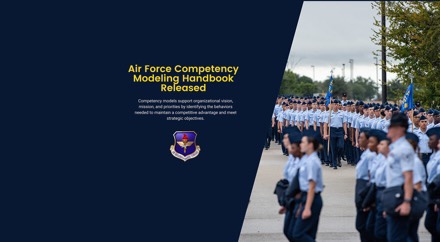
JOINT BASE SAN ANTONIO-RANDOLPH, Texas (AFNS) —
In line with Air Force Chief of Staff Gen. CQ Brown, Jr.’s Action Order A (Airmen) effort to find and enhance universal skillsets that are important to all Airmen regardless of their specific Air Force Specialty Code.
The Air Force Competency Modeling Handbook is now available to Airmen after officially being published Feb. 8.
Developed by Headquarters, Air Education and Training Command A3J team, Air Force Handbook 36-2647 includes a validated competency-modeling framework that is scalable, reliable, and repeatable to assist career fields in developing their occupational competency models. It also outlines the service’s 24 foundational competencies, which are a combination of knowledge, skills, abilities, and other characteristics that manifest in an observable, measurable pattern of behaviors that improve an Airman’s performance.
“Our competencies are the bedrock to developing the Airmen we need, and they provide Airmen with a roadmap to become future-ready, critically-thinking warfighters,” said Brig. Gen. Brenda Cartier, AETC director of operations and communications. “The occupational competency model integrates technical capabilities with the foundational competencies, along with the leadership, combat, joint, social mastery, and all-domain skills needed to be successful in a career.”
In the attachments of AFH 36-2647, Airmen can find detailed definitions for the 24 foundational competencies, which are grouped under four sections: developing self, others, ideas and organizations.
“The foundational competencies are those competencies that are valued by the Air Force and are universally applicable to all Airmen,” said Vincent Villanueva, AETC’s Occupational Competencies branch chief. “These competencies are the core of Airmen development and enable them with tools, pathways, and capabilities to improve their performance in any job, specialty, or situation.”
Competency models support organizational vision, mission, and priorities by identifying the behaviors needed to maintain a competitive advantage and meet strategic objectives.
“The competency model framework enables Airman-centric, mission-focused, competency-based Air Force learning, and as we add career fields, we scale the enterprise-level benefits,” Villanueva said. “It also identifies the competencies needed for key positions and informs decisions for the right person and right job.”
Other features in the handbook include application of competency assessments based on real-world environments and expectations to help Airmen have the right tools and resources in terms of training, education, and experience, Villanueva said.
To access a copy of AFH 36-2647, click here.
By Dan Hawkins, Air Education and Training Command Public Affairs

